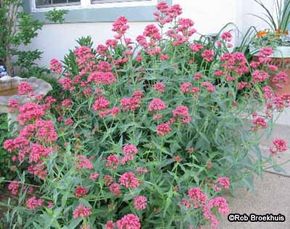Jupiter's beard, also called red valerian, was described as a "cheerful and blowzy plant" when it first turned up in England in the sixteenth century. Plants are often sold as V. coccineus.
Description of Jupiter's beard: Fragrant, 1/2-inch scarlet to red flowers grow in dense clusters on 2- to 3-foot stems. They begin blooming in spring and continue over a long period if old flowering stems are removed.
Advertisement
How to grow Jupiter's beard: Red valerian is not fussy, needing only well-drained soil in full sun, although they will tolerate slight shade. Alkaline soil promotes the best growth. Plants do not grow well if the soil is overly rich. Flowering stems should be cut down to promote new flowers. If flowering stops due to hot summer weather, shear plants back by one-half to one-third to promote another round of bloom in late summer. Valerian self-sows readily and seedlings pop up all over the garden. If this is not desirable, simply hoe or pull out unwanted plants or remove old flowers before they can form seeds.
Propagating Jupiter's beard: By division or seed.
Uses for Jupiter's beard: This plant is best when massed and is often naturalized along old walls and rock outcrops. It makes a long-lasting cut flower and is a good plant to supply butterflies with nectar.
Jupiter's beard related varieties: Centranthus ruber var. alba has white flowers; C. ruber var. coccineus has deep red flowers; and C. ruber var. roseus bears rose-colored flowers.
Scientific name for Jupiter's beard: Centranthus ruber
Advertisement
